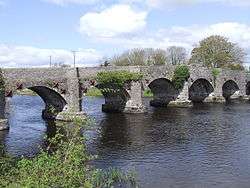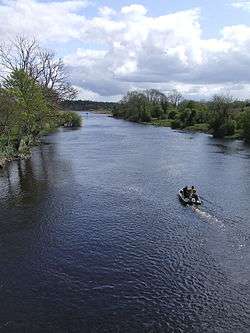Drumsna
| Drumsna Droim ar Snámh | |
|---|---|
| Village | |
| Motto: The ridge of the swimming | |
 Drumsna Location in Ireland | |
| Coordinates: 53°55′44″N 8°00′15″W / 53.92886°N 8.00418°WCoordinates: 53°55′44″N 8°00′15″W / 53.92886°N 8.00418°W | |
| Country | Ireland |
| Province | Connacht |
| County | County Leitrim |
| Elevation | 80 m (260 ft) |
| Population (2002) | |
| • Urban | 173 |
| • Rural | 532 |
| Time zone | WET (UTC+0) |
| • Summer (DST) | IST (WEST) (UTC-1) |
| Irish Grid Reference | N000982 |
| Website |
www |

May 2010

May 2010

May 2010
Drumsna (Irish: Droim ar Snámh which translates as the ridge of the swimming place) is a village in County Leitrim, Ireland. It is situated 6 km east of Carrick-on-Shannon on the River Shannon and is located off the N4 National primary route which links Dublin and Sligo. The harbour dates to 1817 and was a hive of commercial waterway activity until the more northern navigation canal to Carrick-on-Shannon was opened in 1850. Today, the waterway is busy with anglers and tourist pursuits in the summer months but at a much more leisurely pace.
History
In the late 19th century, Drumsna was the main trading town in Leitrim with its own jail and courthouse. It was the resting place for horse-drawn carriages and the harbour was a thriving delivery port. In 1850, the construction of the Jamestown Canal led to a change of the Shannon navigation which altered the status of Drumsna.
Ashfort House, near Drumsna, was originally the home of the Caulfield family. It was purchased by the Waldrons of Cartron in 1744. It was here in January 1848 that Hubert Kelly Waldron JP was murdered in a non-political incident when the local coroner attempted to serve him with a writ.[1]
Until 1996 the main N4 Dublin to Sligo road passed through the village which was then bypassed.
People
- Admiral Sir Josias Rowley, 1st Bt., GCB, GCMG, RN (1765–1842).
- The writer Anthony Trollope (24 April 1815 – 6 December 1882), lived in the village for a period during the 1840s, where he wrote The Macdermots of Ballycloran. Anthony Trollope was remembered in the village with the launch of the Historic Trollope Trail by President Mary McAleese in September 2008.[2]
- Robert Strawbridge (1732–1781), one of the pioneers of Methodism in the United States, was born in Gortconnellan, Drumsna. The Wesleyan historical society erected a memorial to Robert Strawbride in Drumsna in 1992.
- Thomas Heazle Parke, African explorer and surgeon (1857–1893), was born in Clogher House, Drumsna, Co Roscommon.
Amenities and facilities
Angling
Drumsna is widely acknowledged as an anglers' paradise. The many unpolluted lakes and rivers in the area support a huge population of wild fish. Coarse fish species include bream, roach, rudd, hybrids, tench, pike, perch and eels. The Shannon flows through the village and there are several good fishing lakes close by. The Shannon has bream, rudd, roach, tench, perch and pike. Lough Aduff just outside the village is a very good bream and roach water with good tench present to 5 lb (2.3 kg). Headford is a small lake located about 1½ mile north east of the village of Drumsna, this lake has a good stock of bream to 3 lb (1.4 kg) and some very good tench fishing can be had here, especially during the summer months.
Drumsna Roman Catholic Church
Built in 1845 and part financed from the proceeds of a trip to Rome by the then Parish Priest, Father George Geraghty, the building boasts one of the largest church bells in the country. The church also contains a statue to the Virgin Mary which was the only surviving item from Belmount House when it was destroyed by fire. Sunday mass is celebrated in the church by Father John Wall at 9:30 am.
Transport
- Drumsna railway station opened on 1 September 1863, and finally closed on 17 June 1963.[3]
- Drumnsa lies beside the River Shannon with its own jetty. It is a popular stopping point for boats though navigation for cruisers is not possible upstream of here. Boats are required to use the Albert Lock and Jamestown Canal which links to the Shannon upstream of Jamestown, County Leitrim
List of Townlands around Drumsna
- Effrinagh
- Mountcampbell
- Foxborough
- Lavagh
- Lisduff
- Dristernan
- Gortconellan
- Lislea
- Drumnadober
- Charlestown
- Gowel
- Liscallyroan
See also
References
- ↑ The Freeman's Journal, 28 January 1848.
- ↑ http://www.drumsna.com
- ↑ "Drumsna station" (PDF). Railscot – Irish Railways. Retrieved 12 October 2007.